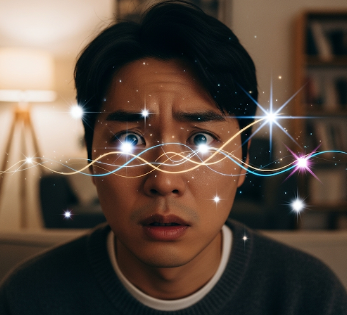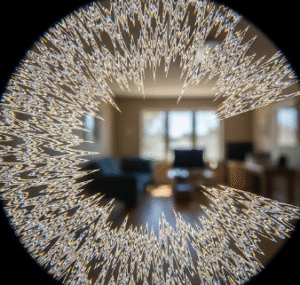Overview
Photopsias, commonly referred to as eye flashes, are perceived flashes of light in the visual field without an external light source. They often appear as brief streaks, sparks, or flickers and can occur in one or both eyes. While occasional photopsias are generally harmless, sudden onset or persistent flashes may indicate serious eye conditions, particularly involving the retina. Understanding photopsias is crucial for protecting vision and identifying potentially urgent problems.
➤ Photopsias can appear as bright flashes, zigzag lines, or spark-like spots in the visual field.
➤ They may occur spontaneously or be triggered by eye movements or pressure.
➤ Immediate evaluation is important if flashes are accompanied by new floaters, dark shadows, or visual loss.
Korean ophthalmology clinics provide advanced retinal imaging, diagnostic tools, and specialized treatments for photopsias, ensuring timely intervention and optimal visual outcomes.
Key Facts
➤ Photopsias are visual phenomena caused by retinal or optic nerve stimulation without actual light.
➤ They may be transient and benign or a warning sign of retinal detachment or vitreous issues.
➤ Common triggers include posterior vitreous detachment, migraines, ocular trauma, or high eye pressure.
➤ Patients may describe them as flashes of light, flickers, or streaks in the peripheral or central vision.
➤ Korean eye care centers offer state-of-the-art diagnostics and surgical interventions for severe or vision-threatening cases.
What is Photopsias?
Photopsias are defined as perceived flashes of light in the visual field without external light stimulation. They are caused by mechanical, neurological, or ocular stimulation of the retina or visual pathways.
➤ Medical perspective: Photopsias result from retinal photoreceptors or optic nerve fibers being stimulated abnormally.
➤ Types of photopsias:
➤ Mechanical photopsias – caused by vitreous traction on the retina.
➤ Migraine-related photopsias – often as scintillating auras preceding headache.
➤ Spontaneous photopsias – occur without clear triggers and may signal retinal or neurological issues.
➤ Appearance: Flashes may be white, colored, or shimmering and can last milliseconds to seconds.
Distinguishing benign flashes from those indicative of serious retinal disease is vital for preserving vision.
What Symptoms Are Related To
Photopsias are often accompanied by other visual or systemic symptoms:
➤ Floaters – small, moving shapes in the visual field, often associated with vitreous changes.
➤ Dark shadows or curtains – may indicate retinal detachment.
➤ Blurred or distorted vision – common with retinal or corneal abnormalities.
➤ Headaches or migraine aura – often precede flashes in migraine-associated photopsias.
➤ Eye pain or pressure – sometimes present with ocular inflammation or trauma.
➤ Sudden vision loss – a warning sign of retinal tears or vascular events.
Recognizing these associated symptoms helps clinicians differentiate between benign and urgent ocular conditions.
What Causes / Possible Causes
Photopsias can arise from ocular, neurological, or systemic conditions:
➤ Ocular causes:
➤ Posterior vitreous detachment (PVD) – vitreous tugging on the retina.
➤ Retinal tears or detachment – sudden flashes may precede visual loss.
➤ Ocular migraines – shimmering or flashing patterns in vision.
➤ Eye trauma or blunt force – causing mechanical stimulation of photoreceptors.
➤ High intraocular pressure – transient retinal ischemia may trigger flashes.
➤ Neurological causes:
➤ Migraine aura – photopsias often precede headaches or neurological symptoms.
➤ Occipital lobe seizures – may induce visual flashes.
➤ Optic nerve or brain lesions – rare but significant cause.
➤ Systemic or environmental factors:
➤ Fatigue, stress, or eye strain can increase sensitivity to visual phenomena.
➤ Certain medications affecting the retina or optic nerve.
Prompt evaluation is essential, particularly if flashes are sudden, frequent, or associated with new visual changes, to prevent potential vision loss.
When Should I See My Doctor
Immediate consultation with an ophthalmologist is warranted if photopsias present with warning signs or sudden onset:
➤ New flashes accompanied by floaters or dark curtains – may indicate retinal tear or detachment.
➤ Visual disturbances with headaches, nausea, or neurological symptoms – may be migraine-related but still require evaluation.
➤ Persistent or worsening flashes interfering with daily activities.
➤ History of eye trauma, surgery, or retinal disorders – increasing risk of complications.
➤ Associated sudden vision loss or blurred vision – an urgent ocular emergency.
Korean eye clinics provide rapid assessment using retinal imaging, OCT, and fundus photography to identify causes promptly.
Care and Treatment
Management of photopsias focuses on treating the underlying cause and preventing vision-threatening complications:
➤ Benign or mild photopsias:
➤ Observation and regular eye exams.
➤ Avoid excessive eye rubbing or strain.
➤ Migraine-associated photopsias:
➤ Preventive medications, hydration, and avoiding triggers.
➤ Lifestyle modifications including sleep regulation and stress management.
➤ Retinal or ocular causes:
➤ Laser therapy or cryotherapy for retinal tears.
➤ Vitrectomy or surgical intervention for retinal detachment.
➤ Management of ocular inflammation or trauma to reduce stimulation.
➤ Lifestyle adjustments:
➤ Reduce screen glare and use anti-reflective lenses.
➤ Protect eyes from bright sunlight using sunglasses.
➤ Monitoring: Follow-up ensures early detection of retinal changes and prevention of permanent vision loss.
Treatment Options in Korea
Korean ophthalmology clinics provide advanced, multidisciplinary care for photopsias and related conditions:
➤ Comprehensive retinal examinations – fundus photography, OCT, and angiography for precise diagnosis.
➤ Laser or surgical interventions – for retinal tears, detachment, or vitreous abnormalities.
➤ Neurology integration – evaluation and management for migraine-related visual phenomena.
➤ Personalized care programs – combining medications, lifestyle counseling, and visual aids.
➤ Emergency retinal services – rapid treatment for vision-threatening conditions.
➤ Ongoing follow-up and monitoring – ensuring early detection and prevention of recurrence.
Patients in Korea benefit from expert retinal specialists, cutting-edge technology, and multidisciplinary approaches, ensuring safe, effective, and timely management of photopsias.













